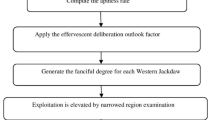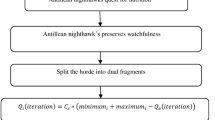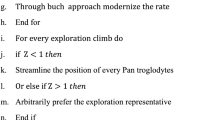Abstract
In this paper Enhanced Apple Maggot Optimization (EAMO) Algorithm is used to solve the power loss lessening problem. Core objectives of the paper are loss lessening, Power constancy augmentation and power divergence curtailing. In Proposed approach normal events of Apple Maggot are used to design the Apple Maggot Optimization algorithm. Outstanding vision and sharing the information, makes the Apple Maggot to discover the foodstuff devoid of complicatedness. Each Apple Maggot upholds a lane from its location and concentration will be in the direction of foodstuff. Dissimilar categories of aroma are compared, and the largest foodstuff area will be selected. Apple Maggot, utilize a capricious direction and expanse to create novel entity position. This capricious method does not create any utilization of the information engendered and it greatly condenses Apple Maggot multiplicity once they not converse with one another. This lessening in diversity will create the procedure vulnerable to local optima. Also the accumulation of solution near to the local optima should be avoided. In the Enhanced Apple Maggot Optimization (EAMO) Algorithm, Bat sonar technique has been amalgamated to augment the diversity, in order to reach the global optimal solution. Authenticity of the Enhanced Apple Maggot Optimization (EAMO) Algorithm is corroborated in IEEE 30 bus system (with and devoid of L-index). Genuine power loss lessening is attained. Proportion of actual power loss lessening is amplified.





Similar content being viewed by others
References
Abaci K, Yamaçli V (2017) Optimal reactive-power dispatch using differential search algorithm. Electr Eng 99(1):213–225
Bäck T, Schwefel H-P (1993) An overview of evolutionary algorithms for parameter optimization. Evol Comput 1:1–23
Carpentier J (1962) Contribution à l’étude du dispatching économique. Bull De La Sociétéfrançaise Des Electriciens 3:431–447
Chellapilla K (1998) Combining mutation operators in evolutionary programming. IEEE Trans Evol Comput 2:91–96
Dai C, Chen W, Zhu Y, Zhang X (2009) Seeker optimization algorithm for optimal reactive power dispatch. IEEE t Power Syst 24(3):1218–1231
Das, Tanmay & Roy, Ranjit & Mandal, Kamal. (2021). Solving Optimal Reactive Power Dispatch Problem with the Consideration of Load Uncertainty using Modified JAYA Algorithm. 1–6. https://doi.org/10.1109/ICAECT49130.2021.9392508.
Das T., Roy R. and Mandal K. K. (2021) Integrated PV system with Optimal Reactive Power Dispatch for Voltage Security using JAYA Algorithm, 2021 7th International Conference on Electrical Energy Systems (ICEES), pp 56–61, https://doi.org/10.1109/ICEES51510.2021.9383711.
Dommel HW, Tinney WF (1968) Optimal power flow solutions. IEEE Trans Power Appar Syst 87:1866–1876
Duong TL, Duong MQ, Van-DucPhan TTN (2020) Optimal reactive power flow for large-scale power systems using an effective Metaheuristic algorithm. Hindawi J Electr Comput Eng 2020:1–11. https://doi.org/10.1155/2020/6382507
Elvira-Ortiz DA, Jaen-Cuellar AY, Morinigo-Sotelo D, Morales-Velazquez L, Osornio-Rios RA, Romero-Troncoso RD (2020) Genetic algorithm methodology for the estimation of generated power and harmonic content in photovoltaic generation. Appl Sci 10:542
Heidari A, Abbaspour RA, Jordehi AR (2017) Gaussian barebones water cycle algorithm for optimal reactivepower dispatch in electrical power systems. Appl Soft Comput 57:657–671
Heidari AA, Ali Abbaspour R, RezaeeJordehi A (2017) Gaussian bare-bones water cycle algorithm for optimal reactive power dispatch in electrical power systems. Appl Soft Comput 57:657–671
Hussain AN, Abdullah AA, MuhammedNeda O (2018) Modified particle swarm optimization for solution of reactive power dispatch. Res J Appl Sci Eng Technol 15(8):316–327. https://doi.org/10.19026/rjaset.15.5917
Illinois Center for a Smarter Electric Grid (ICSEG). Available online: https://icseg.iti.illinois.edu/ieee-30-bussystem/ (accessed on 25 February 2019).
Khazali H, Kalantar M (2011) Optimal reactive power dispatch based on harmony search algorithm. Int J Electr Power Energy Syst 33(3):684–692
Lakshmi S, Ganguly S (2019) An on-line operational optimization approach for open Unified Power Quality Conditioner for energy loss minimization of distribution networks. IEEE Trans Power Syst 34:4784–4795
Li Y, Li M, Wu Q (2014) Optimal reactive power dispatch with wind power integrated using group search optimizer with intraspecific competition and lévy walk. J Mod Power Syst Clean Energy 2:308–318
M. U. Keerio, A. Ali, M. Saleem, N. Hussain and R. Hussain, (2020) Multi-Objective Optimal Reactive Power Dispatch Considering Probabilistic Load Demand Along with Wind and Solar Power Integration, In 2020 2nd International Conference on Smart Power and Internet Energy Systems (SPIES), Bangkok, Thailand, 502–507, https://doi.org/10.1109/SPIES48661.2020.9243016.
Mandal B, Roy PK (2013) Optimal reactive power dispatch using quasi-oppositional teaching learning based optimization. Int J Electr Power Energy Syst 53:123–134
Mouassa S, Bouktir T, Salhi A (2017) Ant lion optimizer for solving optimal reactive power dispatch problem in power systems. Eng Sci Technol, Int J 20(3):885–895
Mugemanyi S, Qu Z, Rugema FX, Dong Y, Bananeza C, Wang L (2020) Optimal reactive power dispatch using chaotic bat algorithm. IEEE Access 8:65830–65867. https://doi.org/10.1109/ACCESS.2020.2982988
Muhammad Y, Akhtar R, Khan R et al (2021) Design of fractional evolutionary processing for reactive power planning with FACTS devices. Sci Rep 11:593. https://doi.org/10.1038/s41598-020-79838-2
Muhammad Y, Khan R, Raja MAZ, Ullah F, Chaudhary NI, He Y (2020) Solution of optimal reactive power dispatch with FACTS devices: A survey. Energy Rep 6:2211–2229. https://doi.org/10.1016/j.egyr.2020.07.030
Pandya, S. and R. Roy, (2015) Particle swarm optimization based optimal reactive power dispatch. Proceeding of the IEEE International Conference on Electrical, Computer and Communication Technologies (ICECCT), pp 1–5.
Polprasert J, Ongsakul W, Dieu VN (2016) Optimal reactive power dispatch using improved pseudo-gradient search particle swarm optimization. Electric Power Compon Syst 44(5):518–532
Pulluri H, Naresh R, Sharma V (2017) An enhanced self-adaptive differential evolution based solution methodology for multiobjective optimal power flow. Appl Soft Comput 54:229–245
R. Roy, T. Das and K. K. Mandal, (2020) Optimal Reactive Power Dispatch for Voltage Security using JAYA Algorithm, 2020 International Conference on Convergence to Digital World-Quo Vadis (ICCDW), Mumbai, India, pp 1–6, https://doi.org/10.1109/ICCDW45521.2020.9318700.
Shanono IH, Muhammad A, Abdullah NRH et al (2021) Optimal reactive power dispatch: a bibliometric analysis. J Electr Syst Inf Technol 8:1. https://doi.org/10.1186/s43067-020-00024-5
Subbaraj P, Rajnarayan PN (2009) Optimal reactive power dispatch using self-adaptive real coded Genetic algorithm. Electr Power Syst Res 79(2):374–438
Takapoui R, Möhle N, Boyd S, Bemporad A (2017) A simple effective heuristic for embedded mixed-integer quadratic programming. Int J Control 93(1):2–12
Tran HV, Pham TV, Pham LH, Le NT, Nguyen TT (2019) Finding optimal reactive power dispatch solutions by using a novel improved stochastic fractal search optimization algorithm. Telecommun Comput Electron Control 17(5):2517–2526
Tudose AM, Picioroaga II, Sidea DO, Bulac C (2021) Solving single- and multi-objective optimal reactive power dispatch problems using an improved salp swarm algorithm. Energ, MDPI, Open Access J 14(5):1–20
Vishnu M, Sunil TK (2020) An improved solution for reactive power dispatch problem using diversity-enhanced particle swarm optimization. Energ 13(11):2862. https://doi.org/10.3390/en13112862
Xin L, Yong L (1999) Guangming, evolutionary programming made faster. Evol Comput 3:82–102
Yang XS (2011) Bat algorithm for multi-objective optimisation. Int J Bio-Inspir Comput. 3:267–274
Funding
The authors have no relevant financial or non-financial interests to disclose. All authors certify that they have no affiliations with or involvement in any organization or entity with any financial interest or non-financial interest in the subject matter or materials discussed in this manuscript.
Author information
Authors and Affiliations
Corresponding author
Ethics declarations
Conflict of interest
The authors have no conflicts of interest to declare that are relevant to the content of this article.
Additional information
Publisher's Note
Springer Nature remains neutral with regard to jurisdictional claims in published maps and institutional affiliations.
Rights and permissions
About this article
Cite this article
Kanagasabai, L. Real power loss reduction by enhanced Apple Maggot optimization algorithm. Int J Syst Assur Eng Manag 12, 1385–1396 (2021). https://doi.org/10.1007/s13198-021-01321-6
Received:
Revised:
Accepted:
Published:
Issue Date:
DOI: https://doi.org/10.1007/s13198-021-01321-6




